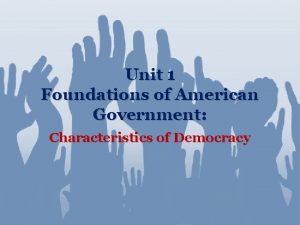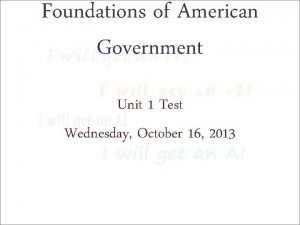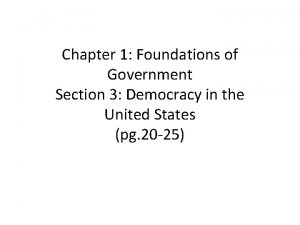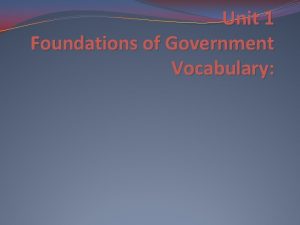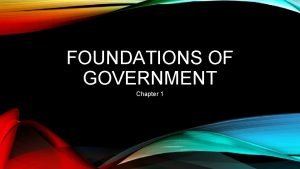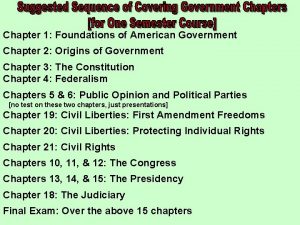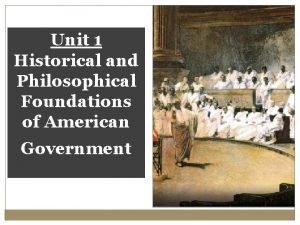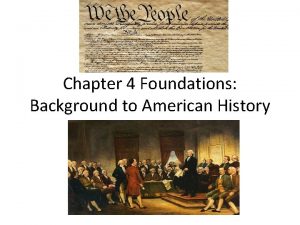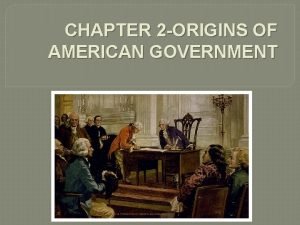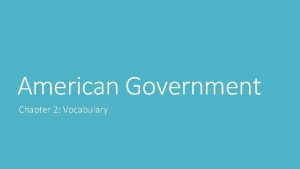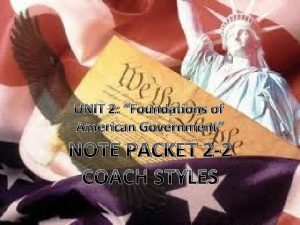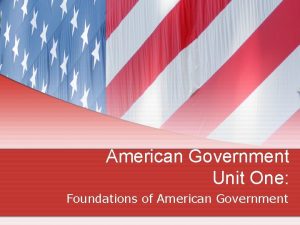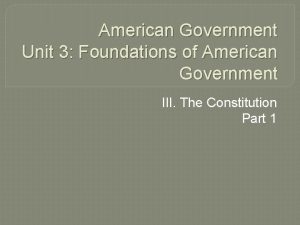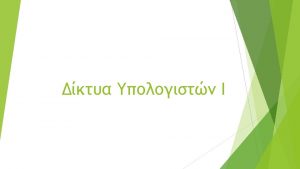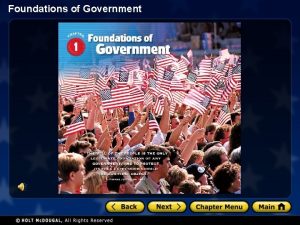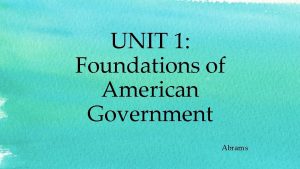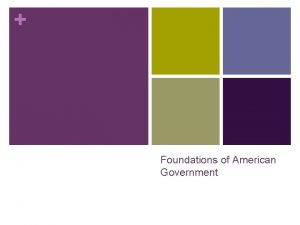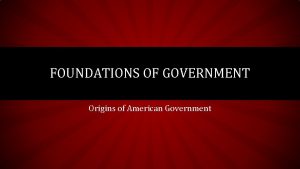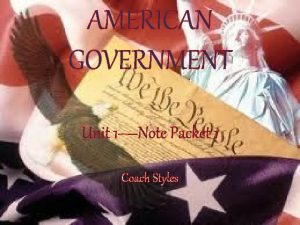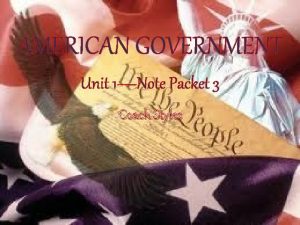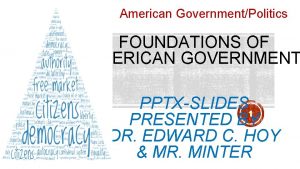UNIT 2 Foundations of American Government NOTE PACKET





















- Slides: 21

UNIT 2: “Foundations of American Government” NOTE PACKET 2 -1 COACH STYLES 12 th Grade American Government

UNIT 2: “FOUNDATIONS OF AMERICAN GOVERNMENT” • Historical Background leading up to American Independence: – English successfully colonize the eastern part of North America – Colonies were established for a variety of reasons: moneymaking ventures, religious freedoms, new beginnings, escaping debts, opportunities for younger sons, etc. – Colonies in America = British colonies / British possessions – Colonists in America = British citizens / British subjects – Colonists in America expected to abide by British laws and pay British taxes—but were not represented in the British government (Parliament) like Englishmen living in Britain – WHY WAS THIS A SOURCE OF ANGER AND RESENTMENT AMONG MANY AMERICAN COLONISTS?

UNIT 2: “FOUNDATIONS OF AMERICAN GOVERNMENT” • HANDOUT: “THE IDEOLOGICAL SOURCES OF RESISTANCE” Q/A ON YOUR OWN PAPER: 1. Identify and describe the THREE INTELECTUAL TRADITIONS from which educated colonists mounted their attacks on new British policies imposed upon the American colonies. 2. Identify the beliefs of colonists who followed John Locke’s reasoning and theories concerning “natural rights. ” 3. What was the primary purpose of English common law and the English political tradition? 4. What three particular issues concerning government did educated colonists and many in England begin to attack in the decades after 1720? 5. What was the “bottom-line” attack against the Stamp Act argued by the colonists?

UNIT 2: “FOUNDATIONS OF AMERICAN GOVERNMENT” • The American Revolution was successful—the sacrifice of committed patriots resulted in a free and independent nation that had found escape from the oppressive, tyrannical rule of the British government. But with as much effort as it had taken to find this freedom, the difficulties had only just begun. • These same patriots would now have to find a way to bring together the different colonies (which were now different states), the different cultures, the different immigrants, the different religious denominations, the different economies, and the different societies into one, unified nation.

UNIT 2: “FOUNDATIONS OF AMERICAN GOVERNMENT” • What is the meaning/translation of the original motto of the United States of America? • “E Pluribus Unum” (Latin): “From Many, One” ________ • With the defeat of the British, the newly independent United States of America struggled to shape a ____ durable form of government that maximized every citizen’s liberty ______ and protected their individual rights ______. • The primary challenge facing the new government was the ability to maintain the proper balance liberty and between ______. order

UNIT 2: “FOUNDATIONS OF AMERICAN GOVERNMENT” • In 1775, even before the start of the actual fighting of the Revolution, the long-established colonial governments had started to crumble. • After the war broke out at Lexington, Concord, and Bunker Hill, several royal governors returned nervously to Britain. By 1776, nearly all of the colonial governments had disappeared—only the local governments (most of them now in the hands of the patriots) continued to meet and carry on business. • With the war finally won, it was now time to make the transition from hopes and dreams to practice and reality.

UNIT 2: “FOUNDATIONS OF AMERICAN GOVERNMENT” • The majority of Americans at this time viewed themselves more as citizens of their respective individual states than as citizens of a nation—in this regard, the United States was not as much of a nation as it was a… – _______ Confederation (def): A loose alliance of independent states. • In those days, it was common practice to refer to “these United States” and not “the United States. ” In 1777, the Continental Congress adopted a new set of laws to govern “these” United States, but it was not ratified until 4 long, war-filled years later.

UNIT 2: “FOUNDATIONS OF AMERICAN GOVERNMENT” Articles • Ratified in 1781, the _______ of _______ Confederation became the first constitution of the United States. – ______ Constitution (def): Body of fundamental _____ laws that establishes the principles, structures, and processes government of ______. • Handout: “The Articles of Confederation and Perpetual Union”

THE PROVISIONS OF THE ARTICLES 1. Under these provisions, which would hold the most power —the state governments or the national government? q Why do you think the Continental Congress (which, after independence was gained changed its name to the “Confederation Congress) set up the powers of government in this fashion? 2. Explain the quotation: “The Articles of Confederation created NOT A UNION, but only bound the States together by a “ROPE OF SAND. ” 3. A) How many branches of government were provided for by the Articles of Confederation? B) What problems might this create in contrast to the first states’ constitutions?

THE PROVISIONS OF THE ARTICLES

UNIT 2: “FOUNDATIONS OF AMERICAN GOVERNMENT” • As Article 2 of the Articles of Confederation stated clearly (and the Tenth Amendment to the Constitution would later reiterate), “Each State retains its sovereignty, freedom, and independence, and every power, jurisdiction, and right, which is not by this Confederation delegated to the United States, in Congress assembled. ” • With the majority of power being held by the ______ states under the Articles, the individual states’ constitutions were extremely important.

UNIT 2: “FOUNDATIONS OF AMERICAN GOVERNMENT” • 4 COMMON FEATURES OF THE FIRST STATES’ CONSTITUTIONS: Popular Sovereignty 1. __________ (def): The idea that government governed exists and functions only through the consent of the _____. Limited Government 2. _________ (def): The premise that the powers limited of the governmentrights are _______ and individuals have certain God-given ______ that government cannot take away. rights liberties 3. Civil ______ and. Powers ____ Separation 4. _____ of _______: Powers of the government were divided into 3 separate branches: Executive 1) 2) 3) _____: Legislative Enforces law (most limited in power) _____: Makes law (given the most power) Judicial _____: Applies law

UNIT 2: “FOUNDATIONS OF AMERICAN GOVERNMENT” • Even though under great strain and many difficulties, the Articles of Confederation held the states together during the Revolution—the primary purpose of the Confederation government was the successful prosecution of the War for Independence—and in this it succeeded. However… limit the power of the central (federal) • In attempting to _____ government, the Second Continental Congress created a government without enough power to govern effectively. • Under the Articles, Congress had the power to wage war, conduct foreign affairs, borrow money, deal with the Indians, and settle disputes among the states. • But, in order to raise an army or cover its bills, Congress could only requisition men and money from the state governments—if the states complied, that was great. But if the states failed to meet their obligations to the Union, Congress had no way to make them. • These were just a part of the problems caused by the weaknesses of the Articles.

UNIT 2: “FOUNDATIONS OF AMERICAN GOVERNMENT”

1. WEAKNESSES OF THE ARTICLES OF 4. There was no executive branch to Each state had one CONFEDERATION vote, • A small state such as Rhode Island had the same voice as a larger state such as New York or Virginia. Although each state might send several members to make up its delegation, those members had to agree among themselves how their state’s one vote would be cast. enforce acts of Congress. • Of course, for the first 8 years under the Articles, the most important “executive” work to be accomplished was victory in the war—for that, General George Washington was the commander-in-chief. 5. There was no judiciary (court system) to apply laws. 6. Articles could be amended only with the consent of all 13 states. • Again, basically relying on donations from the states for financing. threaten this action to get its way and to disrupt the business of Congress. regardless of size. 2. Congress had no power to • This meant that any state held veto regulate trade. power over any amendment or major disputed matters that seemed to call 3. Congress had no power for a change in the Articles. The tiny to collect taxes. state of Rhode Island would repeatedly 7. 9/13 majority needed to pass laws.

UNIT 2: “FOUNDATIONS OF AMERICAN GOVERNMENT” • Due to these weaknesses, the Articles proved to be only a “firm league of _____” friendship between the states, and rope of _____. ” sand instead of a union, created only a “_____

UNIT 2: “FOUNDATIONS OF AMERICAN GOVERNMENT” • Despite its weaknesses, TWO MAJOR PIECES OF LEGISLATION were enacted by Congress under the ARTICLES OF CONFEDERATION: Land Ordinance 1785: 1. _______of Provided for the survey of public lands and the reservation of lands to support _______. public schools In the words of Congress, “Religion, morality, and knowledge being necessary to government and the happiness of mankind, schools and the means of education shall forever be encouraged. ” It is evident then, that from the beginning of this nation, the focus of education was on the moral as well as the intellectual development of our nation’s youth.

UNIT 2: “FOUNDATIONS OF AMERICAN GOVERNMENT” Ordinance of 1787: Set up the mechanism for 2. Northwest _________ the orderly addition of new ______ states and was the first slavery as it was prohibited in the national stand against ____, new territories. • Another critically important feature of the Northwest Ordinance was its treatment of religion. The very first article stated, “No person, demeaning himself in a peaceable and orderly manner shall ever be molested on account of his mode of worship, or religious sentiments, in the said territory. ” This enlightened principal was revolutionary for its time—no other government had ever laid out such a principal for administering newly acquired territories. • Despite the boldness of these ordinances and these advances for civil and religious liberty, the weaknesses of Congress were demonstrated almost daily—the financial situation of the United States was spinning out of control and the Union also showed signs of coming unglued over foreign affairs.

UNIT 2: “FOUNDATIONS OF AMERICAN GOVERNMENT” • In the early 1780 s, a group referred to as the Nationalists sought to _____ strengthen the federal (national) government. • NOTABLE NATIONALISTS: _________ George Washington Ben Franklin ______________ James Madison Alexander Hamilton ________

UNIT 2: “FOUNDATIONS OF AMERICAN GOVERNMENT” • One notable event particularly boosted support for the Nationalist’s cause: – Shay’s Rebellion: Revolutionary War veteran Daniel Shays led an “army” of Massachusetts farmers in an effort to close down the courts to prevent foreclosures and imprisonment for debt. – Without the power to raise an army, Congress could do nothing to stop the rebellion. After 5 months, a state militia finally put down the rebellion. The state militia was raised with funding from local merchants. The captured rebels were sentenced to death, but were soon pardoned. Ben Franklin summarized the nation’s predicament saying, “Having dreaded giving too much power to our governors, now we are faced with the danger of too little obedience in the subjects. ”

UNIT 2: “FOUNDATIONS OF AMERICAN GOVERNMENT” • In 1786, Nationalists held a meeting in Maryland Annapolis Convention for the known as the __________ purpose of discussing the problems caused by the weaknesses of the Articles of Confederation – The major (and pretty much only) accomplishment of the Annapolis Convention was to call for a general convention to be held in Philadelphia in May 1787 to ______ amend and ______ strengthen the Articles of Confederation—this meeting would come to be known as the ____________. Constitutional Convention Amend (def): To ______ revise or _______. change • _______
 Unit 1 foundations of american government
Unit 1 foundations of american government Foundations of american government unit 1 test review
Foundations of american government unit 1 test review Government unit 1 study guide
Government unit 1 study guide Foundations of government section 3
Foundations of government section 3 Chapter 1: foundations of government worksheet answers
Chapter 1: foundations of government worksheet answers Foundations of government vocabulary
Foundations of government vocabulary Chapter 1: foundations of government pdf
Chapter 1: foundations of government pdf Foundations of government (chapter 1 test form a)
Foundations of government (chapter 1 test form a) Philosophical foundations of the american revolution
Philosophical foundations of the american revolution Encounters and foundations to 1800 comprehension answers
Encounters and foundations to 1800 comprehension answers Chapter 4 foundations background to american history
Chapter 4 foundations background to american history Difference between note making and note taking
Difference between note making and note taking What are signal words
What are signal words Difference between note making and note taking
Difference between note making and note taking Financial documents in order
Financial documents in order Draw a specimen of debit note
Draw a specimen of debit note What is a debit note
What is a debit note Relevance of note making
Relevance of note making Simple discount example
Simple discount example National government vs federal government
National government vs federal government Chapter 2 american government
Chapter 2 american government Origins of american government vocabulary
Origins of american government vocabulary
